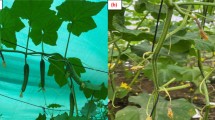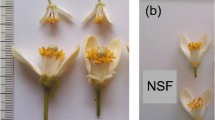Summary
The inheritance of parthenocarpy in the pickling cucumber has been studied with progenies of an incomplete diallel cross between lines with different degrees of parthenocarpy and with two sets of F1, F2 and B1 of crosses between parthenocarpic and non-parthenocarpic lines. The inheritance of parthenocarpy could be explained by three independent, isomeric major genes with additive action, together with a non-allelic interaction of the homozygote-heterozygote type. Indications have been found for linkages between genes that govern parthenocarpy, femaleness and the spined/hairy fruit character. Consequences for breeding parthenocarpic varieties are discussed.
Similar content being viewed by others
References
Garretsen, Frida & M. Keuls, 1973. Analysis of genetic variation in an incomplete diallel cross. Proc. Eucarpia Conf. Biometrics (Hannover, 1973): 24–35.
Garretsen, Frida & M. Keuls, 1977. General and specific reciprocal effects in complete and incomplete diallel crosses. Eucarpia Conf. Biometrics (Gödöllö, 1975) (in press).
Hawthorn, L. R. & R. Wellington, 1930. Geneva, a greenhouse cucumber that develops fruit without pollination. Bull. N. Y. St. agric. Exp. Stn 580: 11 pp.
Juldasheva, L. M., 1973. Inheritance of the tendency towards parthenocarpy in cucumbers (Russian). Byull. vsesoyuznogo ordena Lenina Inst. Rastenievodstva Imeni N.I. Vavilova 32: 58–59.
Kubicki, B., 1969. Investigations on sex expression in cucumber (Cucumis sativus L.). Genet. polon. 10: 5–143.
Kvasnikov, B. V., N. T. Rogova, S. I. Tarakanova & S. I. Ignatova, 1970. Methods of breeding vegetable crops under the covered ground. (Russian, English summary.) Trudy prikl. Bot. Genet. Selek. 42(3): 45–57.
Mather, K. & J. L. **ks, 1971. Biometrical genetics. Chapman and Hall, London; 382 pp.
Pike, L. M. & C. E. Peterson, 1969. Inheritance of parthenocarpy in the cucumber (Cucumis sativus L.). Euphytica 18: 101–105.
Ponti, O. M. B. de, 1976. Breeding parthenocarpic pickling cucumbers (Cucumis sativus L.): Necessity, genetical possibilities, environmental influences and selection criteria. Euphytica 25: 29–40.
Veen, J. H. van der, 1959. Tests of non-allelic interaction and linkage for quantitative characters in generations derived from two diploid pure lines. Genetica 30: 201–232.
Wellington, R. & L. R. Hawthorn, 1928. A parthenocarpic hybrid derived from a cross between and English forcing cucumber and the Arlington White Spine. Proc. Am. Soc. hort. Sci. 25: 97–100.
Author information
Authors and Affiliations
Rights and permissions
About this article
Cite this article
De Ponti, O.M.B., Garretsen, F. Inheritance of parthenocarpy in pickling cucumbers (Cucumis sativus L.) and linkage with other characters. Euphytica 25, 633–642 (1976). https://doi.org/10.1007/BF00041600
Received:
Issue Date:
DOI: https://doi.org/10.1007/BF00041600




